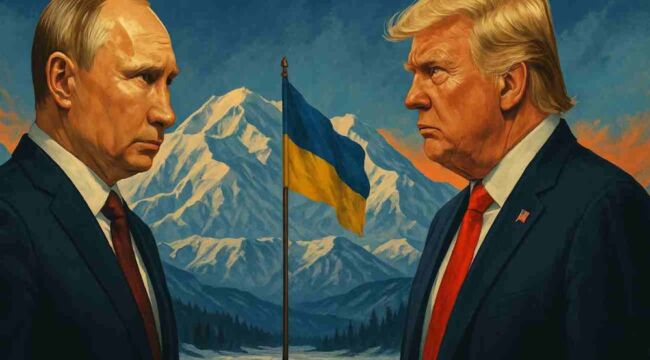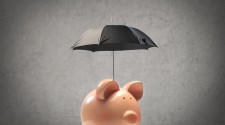Trump vs. Putin: Rickards on the Ukraine Endgame
Tomorrow, President Trump will finally meet face-to-face with President Putin.
The summit will take place in Anchorage, Alaska, as covered in detail by our friend Byron King earlier this week.
President Trump has stated that his primary goal is to reach a ceasefire agreement. If an agreement isn’t reached, Trump told reporters that Russia would face “severe consequences”. He is likely referring to further sanctions and economic punishment.
Putin has taken a softer approach ahead of the summit, praising Trump’s “”energetic and sincere efforts” to end the war. However, Putin is almost certain to stick to his position that Russia will not give up much, if any of its conquered territory.
Further, the Russian leader will almost certainly insist on Ukrainian neutrality going forward. In other words, he will require assurance that the country will never join NATO. He will also likely insist on de-militarization of Ukraine.
These will be hard pills for Zelensky and NATO to swallow, so I am keeping expectations for the summit low. However, the fact that these two leaders are finally meeting in person is undeniably a positive sign.
Rickards’ Analysis
Since the beginning of this conflict, nobody has offered better coverage than Jim Rickards.
Jim says Russia is unlikely to accept an unconditional ceasefire at this time. His reasoning is simple: Russia is winning on the battlefield and achieving its military objectives.
Here’s an excerpt from a recent update Jim sent to subscribers of Insider Intel:
Russian troops are making advances along a 500-mile front from the southern Donbass to Kursk. It only seems slow because the Russia way of war is slow, methodical and lethal. Russian troops do not quickly assault a target city. They spend up to a year taking every village and town adjacent to the target until it is completely surrounded. Only then – when the defenders are isolated and cut off from resupply or rescue – do the Russian go in for the kill. Defenders are given a chance to surrender but are annihilated if they don’t.
This methodical pattern has played out in battles for Mariupol (2022), Bakhmut (2023), Avdiivka (2024) and Chasiv Yar (2025). The next major target is Pokrovsk, a medium-sized city in southern Donbas but a critical logistics hub. Once the Russians take it, the Ukrainian Armed Forces (UAF) will lose the ability to supply other positions along the entire front. At that point, there will be little to prevent Russian victories in Kramatorsk, Slovyansk and Lyman. From there, the Russian army will advance to the Dnieper River and gain effective control of all of eastern Ukraine. That’s not a stalemate; it’s a prelude to total victory.
… This is why Putin has rejected Trump’s call for an unconditional ceasefire. The UAF and Zelensky naturally want a ceasefire to rearm, rest and reposition for a continuation of the war. Russia will never agree because they are winning decisively and have the UAF in full retreat or else surrounded. This is where Trump’s failure to understand Russia and the Russian way of war begins to echo in the global economy.
A “prelude to total victory”. Agreed. Russia is in a strong position on the battlefield.
Ukrainian forces are struggling to hold the line. If they are to continue this war, they need a ceasefire to regroup and re-arm. So it does seem unlikely Putin will agree to a ceasefire without assurance it will lead to a sustainable peace.
Ukraine is running out of cards to play in this war. And the ones they have left are not pleasant to contemplate.
Thus far, Ukraine has resisted conscripting its youngest adults. The military draft currently only covers those 25 and older. However, there has been pressure to lower the age of conscription to 18. That would buy Ukraine time on the battlefield (once those new young soldiers are trained), but it could also demographically doom the country.
It’s becoming clear to even NATO hardliners that it’s time to end the bloodshed. But one primary hurdle remains…
Zelensky: The Missing Man
Notably absent from the summit tomorrow will be Ukrainian President Zelensky. He is, arguably, the greatest obstacle to peace.
President Trump recently expressed frustration with Zelensky’s insistence on not giving up any land. From The Hill:
“I was a little bothered by the fact that Zelensky was saying, ‘Well, I have to get constitutional approval.’ I mean, he’s got approval to go into war and kill everybody, but he needs approval to do a land swap — because there’ll be some land swapping going on,” Trump said.
He added that the land swap will be “for the good of Ukraine,” before adding that a possible deal will also involve “some bad stuff for both” Kyiv and Moscow.
It’s good to see Trump openly acknowledging that in order to end this war, Ukraine is going to have to give up at least some of the land Russia has conquered. The areas Russia has taken are largely populated by ethnic Russians (meaning they speak Russian and identify as such). So it really shouldn’t be such a hard sell.
Zelensky, however, has held strong to his position that Ukraine must get back Crimea, the Donbass, and other areas annexed by Russia. He also insists on a ceasefire as a prelude to direct talks. This is fantasy.
Tomorrow’s meeting is important, but it’s really only a first step towards peace in Ukraine. First, Trump and Putin must come to an agreement on the general terms. Then it seems logical that direct negotiations between Moscow and Kiev will be next.
But who knows? Perhaps Trump has the power to unilaterally make a deal. After all, without U.S. support, Ukraine would quickly fold. And I’m not just talking about weapons. The primary assistance that NATO has provided to Ukraine in this war has been access to our world-leading satellite network, electronic surveillance, and intelligence briefings. Without these assets, Ukraine would be fighting blind.
So Trump does hold some key cards, at least when it comes to leverage over Ukraine. How much Trump’s economic threats scare Putin is the larger unanswered question. Thus far, Russia has survived the economic war quite well.
Given enough time, I believe President Trump and Putin will come to an arrangement. Assuming they can somehow bypass Zelensky, the outlook for peace is looking up.
We’ll know more after the summit tomorrow. I will be watching each leaders’ comments post-summit closely.
Trump needs a foreign policy win, so I am cautiously optimistic that this summit will produce at least some progress towards peace.
We’ll keep you updated.



Comments: